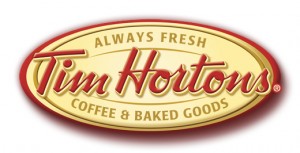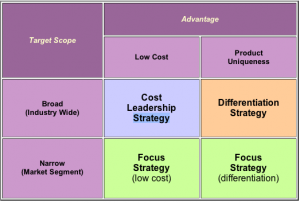Michael Porter argues that an organization’s strength ultimately falls into the categories of cost leadership or product/service differentiation. By applying these strengths, three strategies result: cost leadership, differentiation, and focus. (See Porter’s Generic Strategies)
Tim Hortons is a firm competing in the coffee and bakery industry, and is one of the most successful. According to this blog, they “provide their customers with a sense of national identity and pride.” In other words, their marketing strategy can be categorized in the “focus” section of Porter’s chart. Tim Hortons may not have the best of anything, but the emotional connection and brand loyalty they enjoy in Canada is exceptional. The title of Sally’s refers to Tim Hortons as a “Canadian Icon”, and so it should. Named after a Canadian Ice Hockey player, they have ingrained themselves into the Canadian culture. Although they may not offer any special product only unique to their store, they have focused on the Canadian consumer market and succeeded in building a coffee franchise empire.
“As Canadians, we’re a little bit insecure culturally, given U.S. media and cultural domination, whether it’s the CBC — our TV network — hockey [or] Olympic victory, we cling to our remaining cultural icons. Tim’s is one of them.” – Pete Blackshaw
Although the focus strategy is not the only way they compete in their industry, it is definitely one of the most prominent strategy.
Reference:
- “Sally Chen’s Blog.” Sally Chen’s Blog. Sally Chen, 24 Sept. 2012. Web. 09 Oct. 2012. <https://blogs.ubc.ca/sallychen/>.
- “Porter’s Generic Strategies.” Porter’s Generic Strategies. N.p., n.d. Web. 09 Oct. 2012. <http://www.quickmba.com/strategy/generic.shtml>.
- “Why Do Canadians Love Tim Hortons So Much? – Coffee Blog.” Why Do Canadians Love Tim Hortons So Much? – Coffee Blog. N.p., n.d. Web. 09 Oct. 2012. <http://www.wired.ca/why-do-canadians-love-tim-hortons-so-much-022022.php>.


